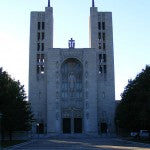If you recall what we talked about the last time, you may remember that we discussed Modern architecture. Although well-received, it was criticized for being too straightforward. A more elaborate style reminiscent of the past was demanded by many.
Thus, Postmodern architecture came to rise. With diversity in aesthetics and intricate techniques, Postmodernism drew from the past movements to create a style that is not only functional, but also looks good. Although Modern architecture based its form on a structure’s function, the Postmodern movement balanced things out.
Below are some features of Postmodern architecture.
The “Anything Goes” Attitude
 The Sony Building
The Sony Building
Image source: Wired New York
Architects normally use unconventional touches to buildings that would still look aesthetically appealing. For example, the Sony Building (formerly the AT&T Tower) sports a classic pediment infused with the blocky look common in modern offices.
Color Scheme
 Portland Municipal Services Building
Portland Municipal Services Building
Image source: Wikipedia
Colors in Postmodern architecture don’t necessarily adhere to the color wheel. They would appear unbalanced and aren’t really consistent, but would still look pleasing nonetheless. The Portland Municipal Services Building’s color scheme is an example of such. The color pattern is a combination of green, flesh, and dark-brown and appear contrasting to each other.
"Less is Bore"
 San Antonio Public Library
San Antonio Public Library
Image source: LarrySpeck.com
Countering Modern architecture’s emphasis on “less is more,” the minimalistic approach has been eschewed in favor of whim while not looking out of place. The San Antonio Public Library in Texas may be cited as an example. With an unconventional color scheme following the previous point, the building sports a Mediterranean tone on the Southeastern and Southwestern facades and magenta on the Northeastern façade. Additionally, ornaments such as the spheres shown above have been incorporated.
Postmodernism also affected church architecture. Nowadays, Postmodern churches have been sprouting everywhere.
Examples of Postmodern Churches
Cathedral of Mary Our Queen, Baltimore
 Image source: Wikipedia
Image source: Wikipedia
Immaculate Conception Church, New Jersey
 Image source: Panoramio
Image source: Panoramio
Church of the Resurrection, New Albany
 Image source: Shirk & O'Donovan
Image source: Shirk & O'Donovan
Through its unconventional approach on architecture, Postmodernism spread from America to Europe, and then throughout the rest of the world. It enhanced people’s perspective on architecture, not settling for what is commonly applied. That might just be the reason for its resilience!
With the Postmodern movement, we end our church architecture series. We hope you gained valuable insights on the evolution of church buildings from the dawn of Christianity to the modern world. Until next time!
References:
Characteristics of Postmodern Architecture, RinkDesign.com
Postmodern Homes, Jackie Craven, About.com
Defining Postmodern Architecture and Its Characteristics, Cockrams Surveyors
Postmodern Architecture, Saylor.org
Postmodern Buildings: Architecture, E-Architect


